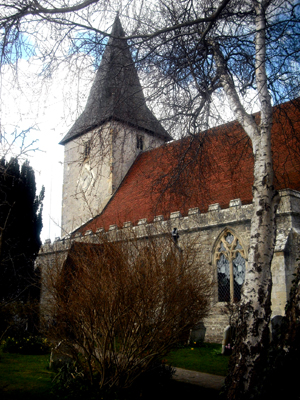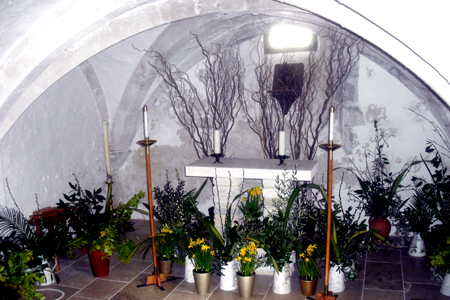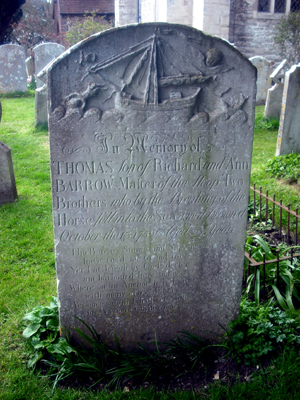| |
 |
 |
 |
| Comment on this report, or find other reports. |
 |
| Our Mystery Worshippers are volunteers who warm church pews for us around the world. If you'd like to become a Mystery Worshipper, start here. |
 |
| Find out how to reproduce this report in your church magazine or website. |
|
|
| 2999: Holy Trinity, Bosham, England |
 |
 |
 |
Mystery Worshipper: Teutonic Knight.
The church: Holy Trinity, Bosham, West Sussex, England.
Denomination: Church of England, Diocese of Chichester.
The building: A gem among the ancient churches in Sussex. Its origins lie in the 5th century, when a community of monks lived here. The Venerable Bede mentions the locality in his Ecclesiastical History of the English People. It is in this church that Earl Harold prayed before he set sail on the ill-fated voyage to Normandy in 1064, and who met his end at the hands of the party of the Duke of Normandy, William the Conqueror. Legend has it that Harold is buried here. The Bayeux Tapestry, the famous artifact that depicts events leading to the Norman Conquest, depicts the chancel arch. A replica panel of the Tapestry was recently made to scale by a local parishioner and is on display behind glass. There are several unusual architectural features in this church, including an elevated chantry chapel on the flat roof of the crypt, a piscina with a hollow pillar through which the water drains directly into the ground, and an early tomb believed to be that of King Canute's young daughter who drowned in the local mill stream. The churchyard has an unusual gravestone that accurately depicts the tragedy of a seafarer who fell overboard and drowned in 1759 at age 25.
The church: There wasn't much to go on in the church itself on this Good Friday, as all the hangings, altar furnishings, etc. had been removed, along with all displays save for a recent work by the Sunday school. It was stark. Their website gives some clues: they have a strong outreach programme and support a good number of charities – local, national and international; secular, ecumenical and Anglican. They are obviously a well-off parish. Very unusually for Anglican churches in this area, about a quarter of their congregation are under the age of 16. They run Alpha courses and take spiritual growth seriously. St Nicholas Church Hall, a secondary post-war "daughter church", houses community groups and hosts church activities.
The neighbourhood: Bosham is a picturesque village on the Bosham Channel of Chichester Harbour, a small boat sailor's paradise. The sailing club's boathouse is built on stilts in the harbour. The roads adjacent to the harbour flood at high water, as some incautious tourists regularly find out. The green overlooks the harbour, and on this beautiful sunny day it was extremely busy. There is a war memorial with tidal gates. There are also a well-known pub, several tea shops and artists' galleries.
The cast: The Revd Martin Lane, vicar, and two retired clergy: the Revd Jan Emerson and the Revd Mervyn Banting. All three were attired in alb and red stole. Not a chasuble in sight.
The date & time: Good Friday, 25 March 2016, 2.00pm.
What was the name of the service?
Good Friday Liturgy.
How full was the building?
It was almost totally empty. When I took to my pew ten minutes before the start of the service, there was no one visible in the church at all apart from a server who handed me the order of service. We exchanged a few pleasantries and I sat about five rows from the back, expecting a few more people to turn up. Alas, by the start of the service I was sitting in what now had become the front pew, with a few bodies (four?) behind me.
Did anyone welcome you personally?
I had been planning to attend the ecumenical walk of witness with Stations of the Cross down from the church hall, but I arrived too late due to a road rage incident. As I approached on the church path, I met one clergywoman who came out of the church after the ecumenical walk. She gave a radiant smile and said hello. This being Good Friday, I expected no welcome whatsoever when I entered the church. I was pleased that a server was stationed by the door on welcome duty. I commented on what a pity it was that the bells were silent, as the green was absolutely teeming with people who had no idea at all that something was going on in church a few yards away. I know it is not customary to ring during Holy Week, but perhaps a single bell tolling might call people to worship?
Was your pew comfortable?
Standard pews, not too cosy, but then it was Good Friday. The church was almost too well heated, which is rather unusual in the more ancient churches around here.
How would you describe the pre-service
atmosphere?
The preparations that had started an hour or so beforehand were quite noisy and distracting, as was the chatter of the altar party and choir members. I retreated into the crypt for a bit of peace, where flowers had been placed before an altar to represent the Garden of Gethsemane. It was quiet after the preparations were completed. The board telling potential visitors that a service was "in progress" was possibly put out a bit too early at half past one, considering the local church folk made more noise than the quietly reverent visitors.

What were the exact opening words of the
service?
"Almighty Father, look with mercy on this your family..." – the collect for the Good Friday liturgy, with the words "wicked men" substituted for "sinners."
What books did the congregation use during the
service?
Hymns Old & New, and an order of service sheet for Good Friday, complete with all the readings including the dramatised gospel, with highlighted parts and rubrics for the congregation. It also had an insert with the words for the proclamation of the Cross. Bibles were available in the pews.
What musical instruments were played?
Organ and a sizeable choir of about 18 singers. Good to see a couple of teenagers among them.
Did anything distract you?
A few things: (1) the rather expansive conducting style of the director of music, who waved his arms vigourously about during the anthem (Stainer's God So Loved the World); (2) some rather unsightly black radiators affixed to the wall behind the altar, visible only because the altar frontal had been removed; (3) the alb of one of the servers, which was much too short (sorry to be picky about this).
Was the worship stiff-upper-lip, happy clappy, or
what?
Dignified and reverential, understated and much less showy than expected a few miles from Chichester, a high castle of Anglo-Catholicism. The dramatised gospel was read by the clergy, a couple of choir members, and servers, with some verses for the congregation.
Exactly how long was the sermon?
7 minutes.
On a scale of 1-10, how good was the preacher?
7 – The vicar reminded me of one of the better-known book-publishing English bishops who used to be priest in charge not far from here – which made me positively inclined toward him.
In a nutshell, what was the sermon
about?
The vicar used one of his favourite hymns, "When I survey the wondrous Cross" by Isaac Watts, as an anchor to challenge us. What does the Cross mean to us personally. What sense do we make of the pain in the world in our own time in view of the Cross? His own answer was the final verse of the hymn: "Love so amazing, so divine, demands my soul, my life, my all."
Which part of the service was like being in
heaven?
Although it was not a particularly accomplished performance, I was moved to tears during the rendition of the Stainer. It was sufficient to do the job in the framework of the liturgy of the day, and was what I had come for. Also, the singing voice of the vicar was rather good during the proclamation of the Cross.
And which part was like being in... er... the other place?
After the clergy and choir had finished the veneration of the cross in the customary manner, the congregation were invited to do the same. It was a very lonely and long walk to the Cross for me from my "front pew at the back of the nave" as no one else came forward. My personal Calvary on the day. So you couldn't really call it "hellish," but rather fitting.
What happened when you hung around after the service looking lost?
This was not a day to experiment. We all left quietly.
How would you describe the after-service
coffee?
None. However, none of the teashops in the village seemed to serve hot cross buns.

How would you feel about making this church your regular (where 10 = ecstatic, 0 = terminal)?
5 – The website says they are a "vibrant" parish, but this was clearly not a service with which they connect. I would have to experience an ordinary Sunday here.
Did the service make you feel glad to be a
Christian?
Well – I'm glad I came. It was a fitting setting for the journey to the Cross at this time. Is that the same?
What one thing will you remember about all this in seven days' time?
The walk to Calvary in King Harold's church. |
|
|
 |
 |
 |
| We rely on voluntary donations to stay online. If you're a regular visitor to Ship of Fools, please consider supporting us. |
 |
 |
 |
| The Mystery Pilgrim |
 |
| One of our most seasoned reporters makes the Camino pilgrimage to Santiago de Compostela in Spain. Read here. |
 |
 |
 |
| London churches |
 |
| Read reports from 70 London churches, visited by a small army of Mystery Worshippers on one single Sunday. Read here. |
| |
|
|
|
|


